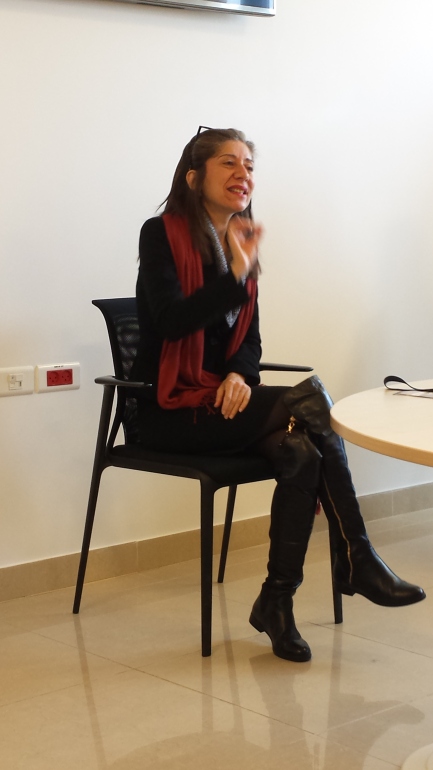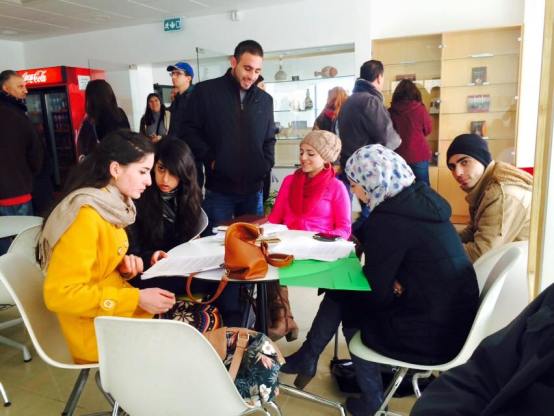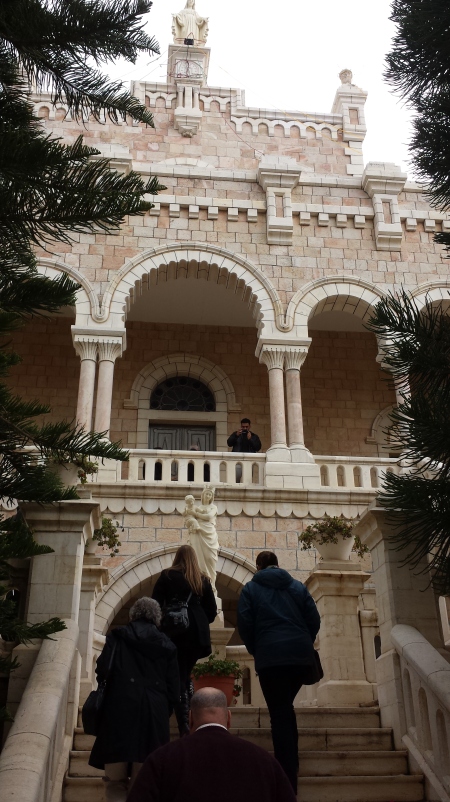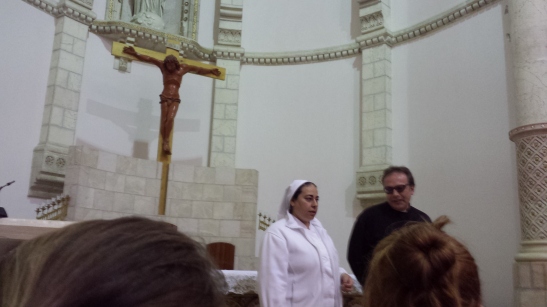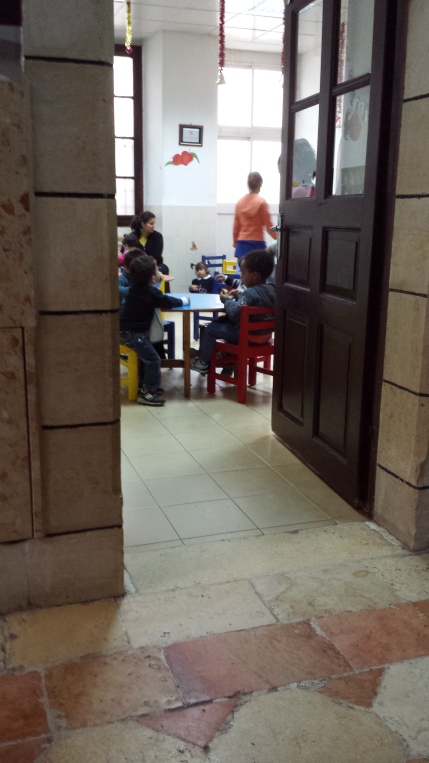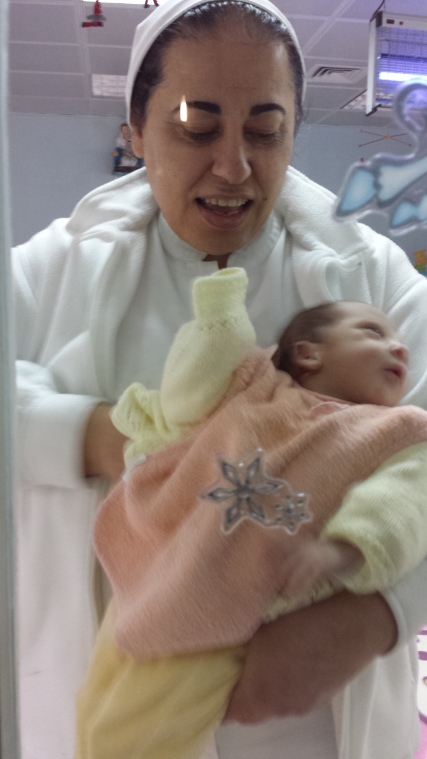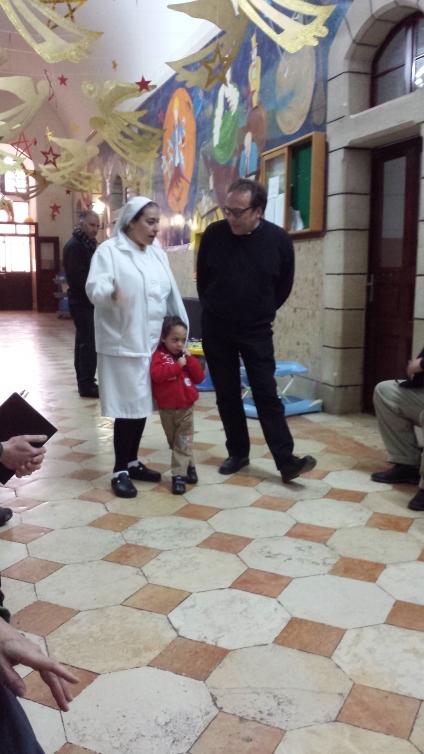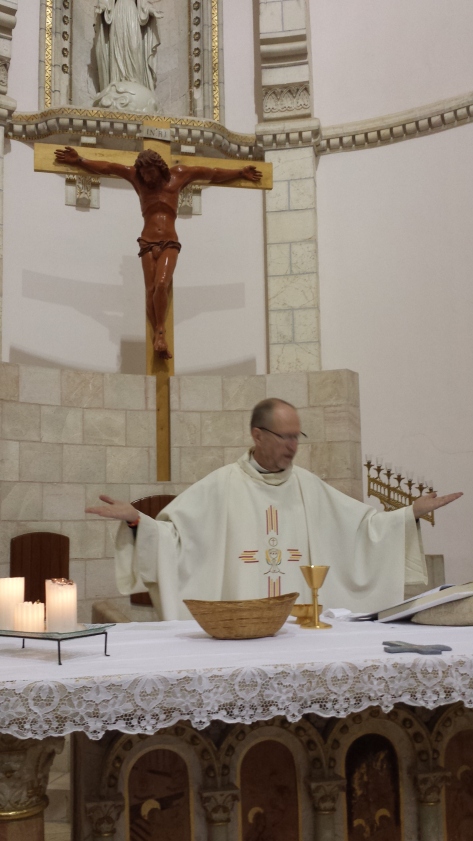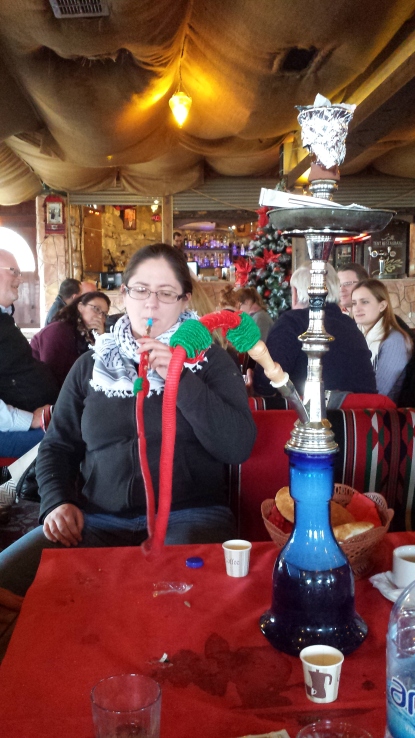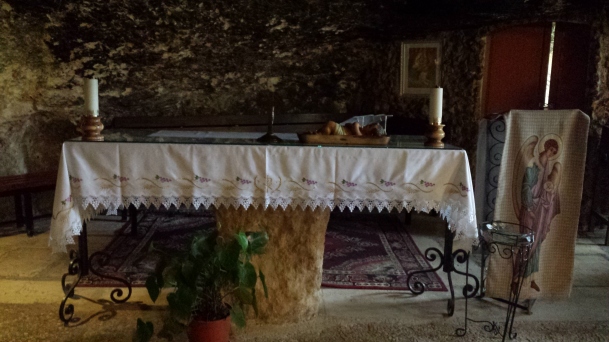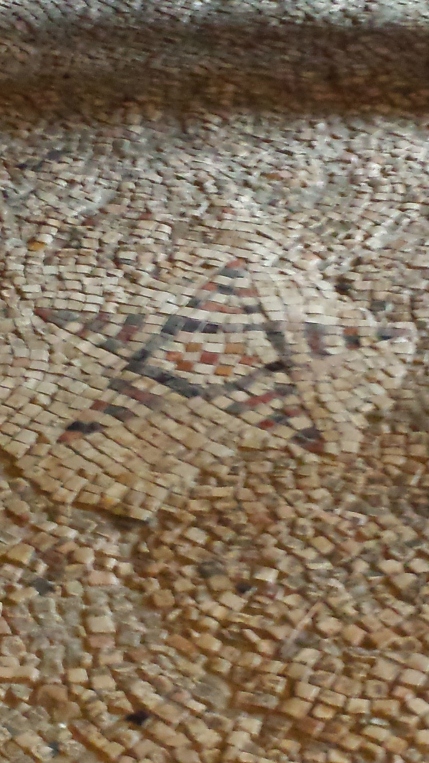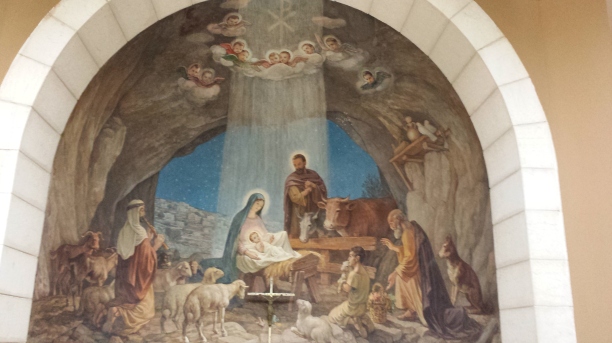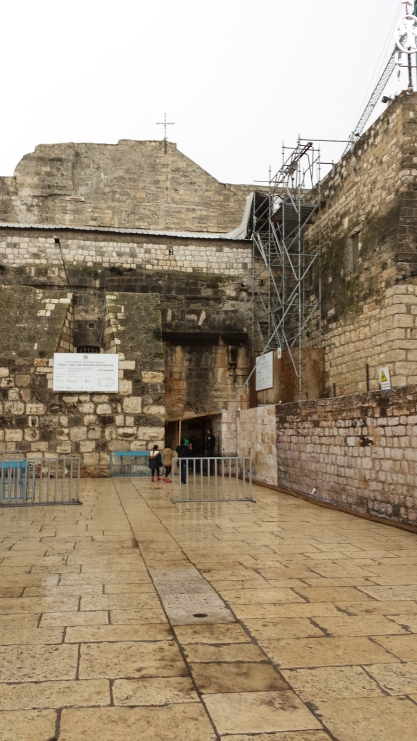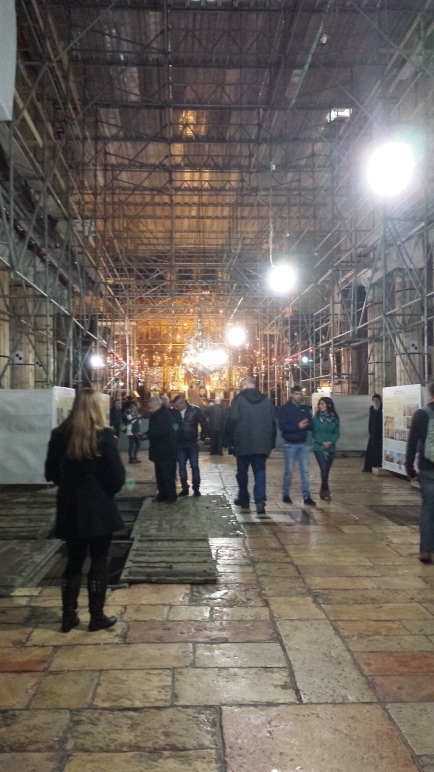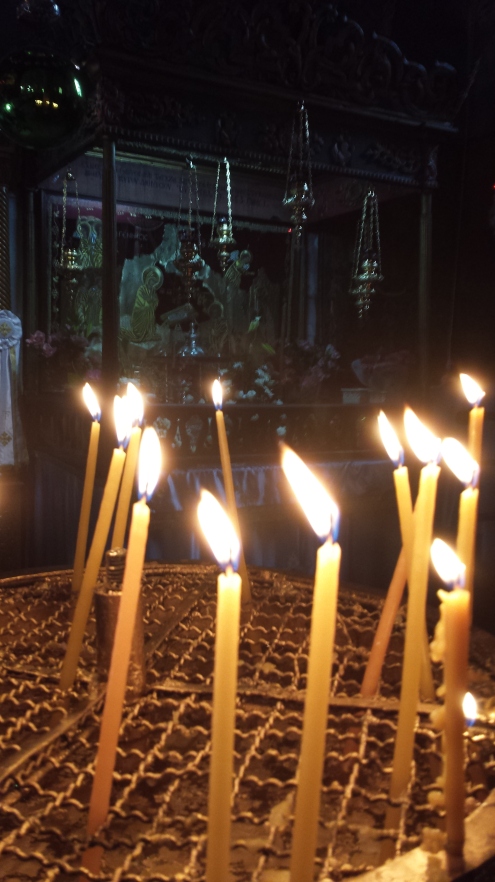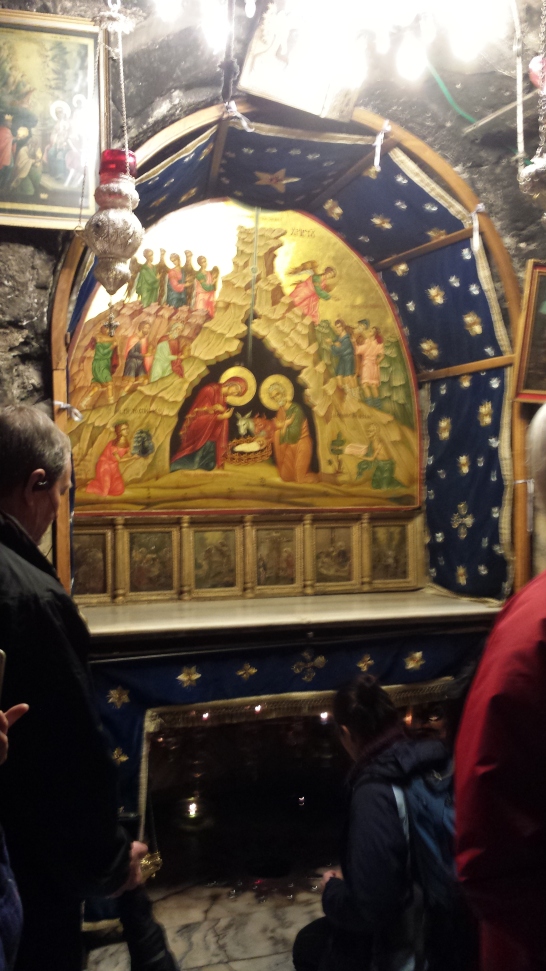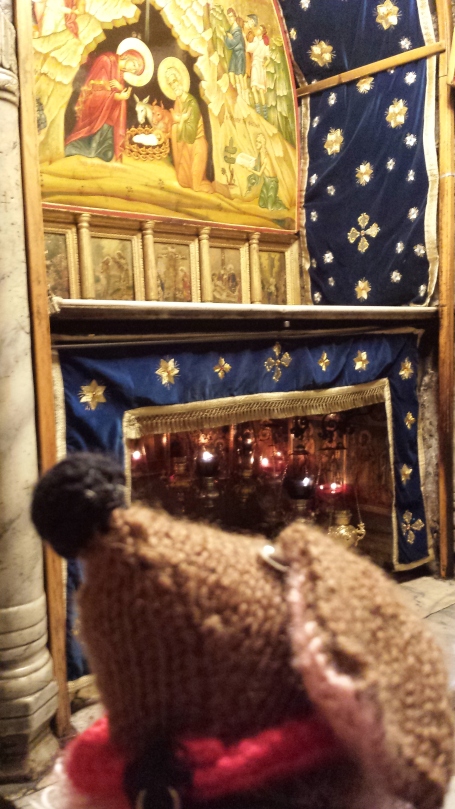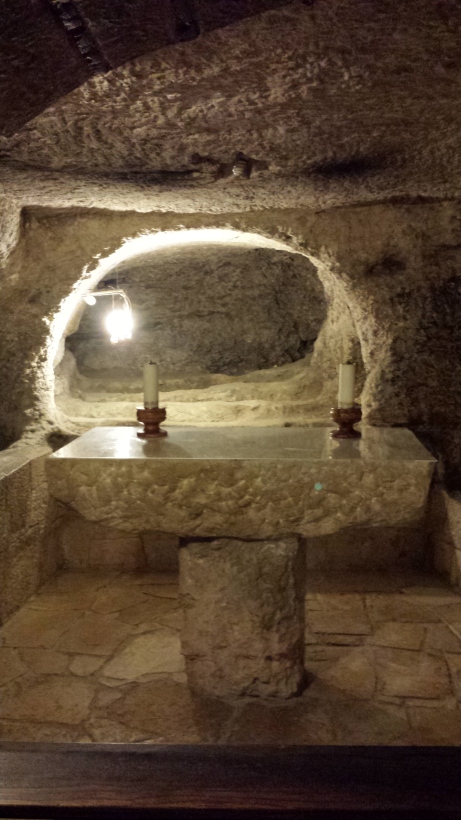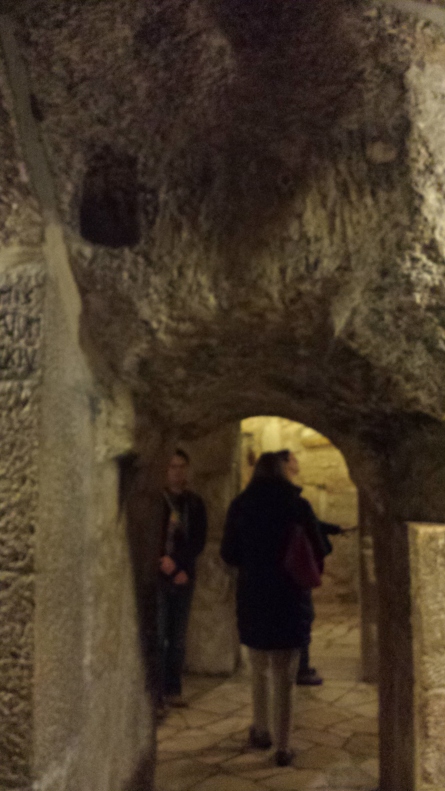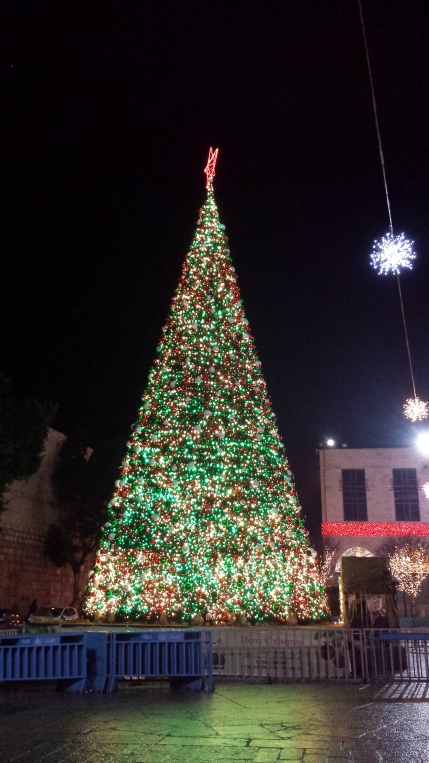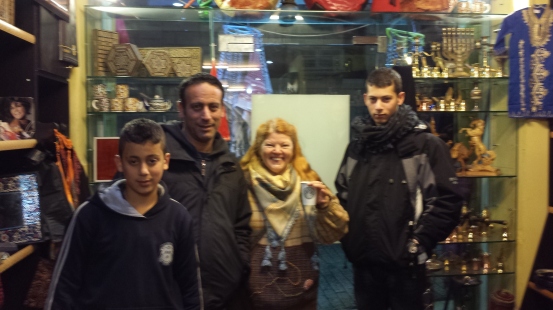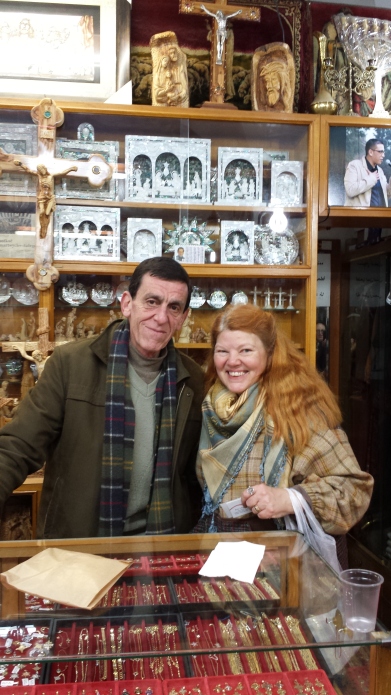January 17, 2015
Waking up on Manger Square in Bethlehem is such a surreal experience. Three different Christmases are celebrated here – the date for Western Christianity, the date for Orthodox Christianity and the date for the Armenian Church (which is actually on January 19th.
Today was all about Bethlehem and visiting the important work and ministries of the Christian communities here.
First, we traveled to Dar al Kalima, a college dedicated to fine arts and bringing this reality and creativity and identity to Palestine. We met with Dr Nuha Khoury, She shared with us how the college is part of the wider work of Diyar – which is based in the International Center of Bethlehem. The programs here focus on cultivating the artistic growth and promotion of Palestinian arts and culture. Young adults can get undergraduate degrees in Dramatic Arts and Graphic Arts. They also have programs in the culinary arts, music and tour guiding. They are planning the development of more programs, such as dance and restaurant management. All of this was the vision of Lutheran Pastor Mitri Raheb, whose books about Palestine are very powerful and recommended reading for those who want a better understanding of everything that is happening today in Palestine.
In the context of Israeli occupation and removal of Palestinians from their traditional homelands, Dr Khoury said at one point, “Art is the way for people to have identity without land. It is very important to have.”
After a wonderful time hearing from and speaking with Dr.Khoury, we toured the college and had the chance for a break in the student lounge.
Next, we traveled a short distance to the Sisters of Charity Orphanage within the grounds of the Holy Family Hospital (often referred to here as the St Vincent Creche). The sisters are contacted by Muslim women from all over the West Bank. In most cases, the babies raised at the orphanage are birthed by young Muslim women who are often raped, sometimes by their own family members. Young Muslim women can face death if found to be pregnant out of wedlock, and most of the births are induced six months into the pregnancy before the mother’s pregnancy begins to show. So, most births are by intention premature. The sisters work closely with hospitals that can initially care for the preemies before they can come to the orphanage nursery.
The sister who spoke with us (in French, translated by Fr. Paul Kennington from Montreal who is helping to guide our group) and gave us a tour of the orphanage has been working there for 19 years. She is sincerely devoted to the children and spoke of how difficult it is that the children must leave the orphanage at the age of six years old. The Muslim tradition does not believe in adoption, nor are the children (by law) allowed to be raised in the Christian faith while living at the orphanage. As a result, the children are not raised in any faith tradition, and they live in different facilities of care until they must go out on their own and try to make a life for themselves.
Sister told us a story of how she was trying to answer a child’s question, “What is Christmas?,” without using any religious language. She made it into a story about a young woman and her husband who couldn’t find a place for her to give birth because there was no room. One of the children to whom she was telling the story interrupted, “Why didn’t they come here to the orphanage? We have plenty of room!” Sister continued her story to the children, explaining that the couple having their child were very poor. Another child interrupted again, saying, “That baby’s not poor, Sister; the baby’s got two parents, and we haven’t got any.”
Needless to say, between the Sister’s sharing with us and the tour itself, all of our group were in tears at one point or another.
After our tour of the orphange school and nursery, we returned to the chapel for Eucharist. Bishop Kirk Smith of Arizona presided, with Bishop Barry Beisner of Northern California preaching. As part of our service, we sang several Christmas carols all heralding and celebrating the birth of the infant Christ. Sung in this setting, these all took on especial significance. The fact that all of Bethlehem and the orphanage are still decorated for their Christmas season was like celebrating Christmas all over again, and Rachel and me were very moved by the whole experience.
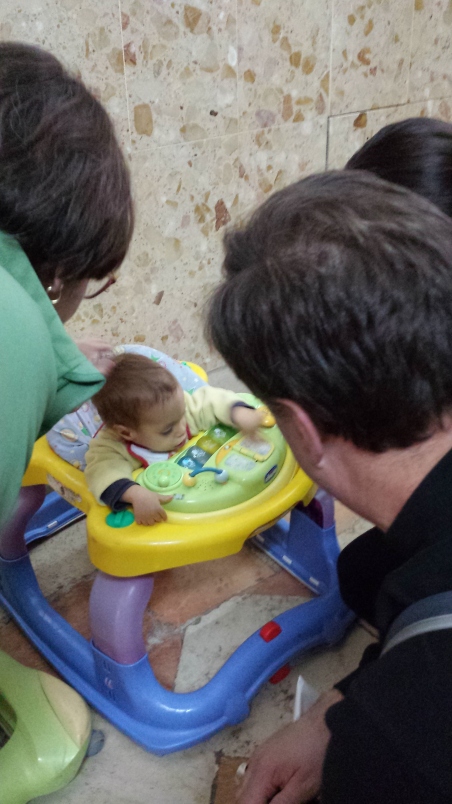
This little boy is blind and was found abandoned in a card board box. None of the children are permitted to have Christian names.
As with each of our special stops like this one, the bishops gifted Sister and the orphanage with funds from each of the diocese sponsoring this trip. We were able to give the orphanage about a thousand dollars, but they need year-round donors to maintain the important work they do.
At our lunch time that followed, our table groups continued to talk about our experiences at the orphanage as we ate in a traditional Palestinian setting. After dessert, it just so happened that our table was the one gifted with the opportunity to partake of a hookah, a traditional extension of hospitality to visitors. The tobacco in this particular hookah was “watermelon mint,” which while it may sound dubious was deemed quite good by those who partook of it (it’s considered rude towards the hosts to not do so).
So that we would have a better understanding of how life was in first century Palestine, when Jesus was born in Bethlehem, we visited a small church set within a first century cave home called The Shepherds’ Field. Ghassan explained how people lived in these types of homes, with sections of the cave divided into separate living areas and rooms by hanging hides. The part of the cave closest to the entrance was usually a common area like a living room and food preparation area, while the sleeping areas were towards the middle and back of the cave. Stored goods and animals were housed at the farthest back of the cave, and this is the area of a such a home where Mary gave birth to her child – the most private part of the cave home, which is why traditional lore about the Nativity story places animals and a feeding bin (manger) in the scene of Jesus’ birth.
This was very good preparation before our visit to the Church of the Nativity, the entrance for which is just steps away from our current pilgrim hotel, the Casa Nova.
A couple years ago, the Church of the Nativity experienced a fire, so much of the large Byzantine and Crusader sections of the church are being restored. Scafolding is everywhere and much of the historic art is covered over. In spite of this, we entered just when the Greek Orthodox priests were holding their prayer service. The expectation of the monks is that visitors will stay silent at all times, but we could hear Ghassan’s explanations about the church through our electronic listening divices linked to a microphone he was wearing.
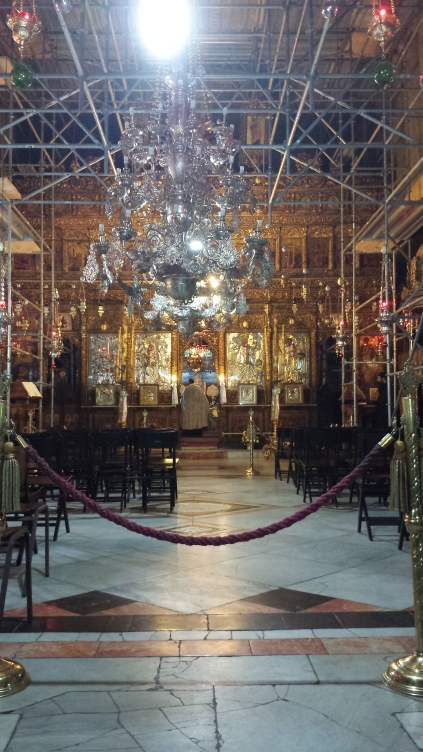
Sanctuary, Church of the Nativity – behind this altar are the steps down to the first century cave of the Nativity.
To get to the first century occupation level of the church requires going down a steep and narrow set of stone stairs down into what was the back of a large cave system in which people had lived during the first century. Today, the spot at the back of the cave associated with Jesus’ birth is “encrusted” or decorated with marble, brass and velvet hangings. It doesn’t look ANYTHING like it would have then, which is why the earlier visit to Shepherds’ Field was important.
Pilgrims can kneel beneath a marble shelf to crawl a little ways into what looks a bit like a fireplace opening. A large brass star in inset into the floor in this nook, and at it’s center is an eight inch opening through which a pilgrim can reach down to touch the smoothed floor of the cave occupation level where the manger is said to have been. The exact spot is something of a guess, but the different levels of churches placed here going back to the forth century make this the location and cave dwelling that the early church very much believed Jesus was born.
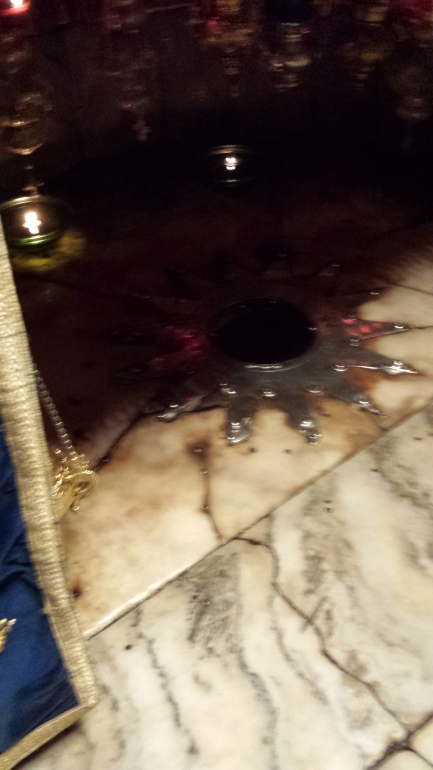
Pilgrims can then reach down through the center of the brass star inset in the floor of the shrine in order to touch the floor of the first century occupation level.
The back of the cave, now a shrine, has been separated from the rest of the cave system by a Byzantine wall. But pilgrims can still explore the rest of the cave by exiting the shrine and going into another section of the church – a much newer nave that you may have seen on television if you ever watch Christmas Eve being celebrated in Bethlehem. The folks who run this church are much less grumpy, but you still have to be quiet.
Descending the staircase here gives you access to the rest of the cave and some more of a system of tiny pocket caves which are now varous side altars and chapels. It is believed that St. Jerome and his assistant, Eusebius, used one of these smaller caves as the place where they worked on the research, editing and selection of the Scripture that we have inherited as the canon of the New Testament. St. Jerome was buried in yet another one of the small caves after his death, but his body was moved to Rome at some point in history.

Ghassan and Sarah in front of the entrance to our hotel, Casa Nova just outside the entrance of the Church of the Nativity.
After an amazing day of learning and reflection, our group had the chance to explore the Bethlehem suk and shops around the central square. We had the chance to visit the shop associated with the college we visited earlier in the day and to support the art students by buying the crafts they have made and the books written by their faculty and others.
We also visited the Bethlehem Peace Center shop, where Rachel picked up a small but powerful olive wood nativity.
Shopping in the suk requires being comfortable with bargaining respectfully for a good price, otherwise the unwary pilgrim will be utterly fleeced like a sheep. Whatever one spends here, though, goes to supporting a beleaguered economy and people cut off from the easy market place of the rest of the world. It’s hard to begrudge people who are simply struggling to make ends meet.
One shop Rachel and me wandered into has been around since 1929 and specializes in items made from mother of pearl – an old art form in Bethlehem. Rachel was sorry to learn that the $35 dollars she spent there was the first sale the owner had had all day, and it was 6:30pm. He was a very kind Catholic man, and we talked for a while about what life is like for the people of Bethlehem, behind the separation wall that cuts across what was once a vital market street – demolishing all that was once there.
After dinner with our group back at the Casa Nova, we met with Dominic and Paul to talk about what Lightline tour company (allied with Shepherd Tours) can offer to clergy who may be untested to bring a group on tour. Rachel is certainly interested to bring a group from Trinity, so she is thinking to plan a trip for 2017.
Off to bed for tired and full good doggies.
Here’s to barking at squirrels!
Henry

